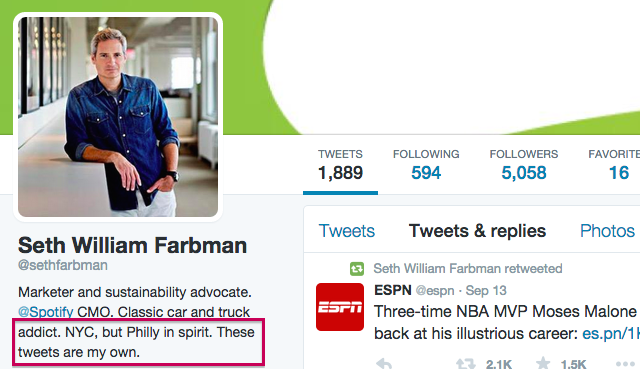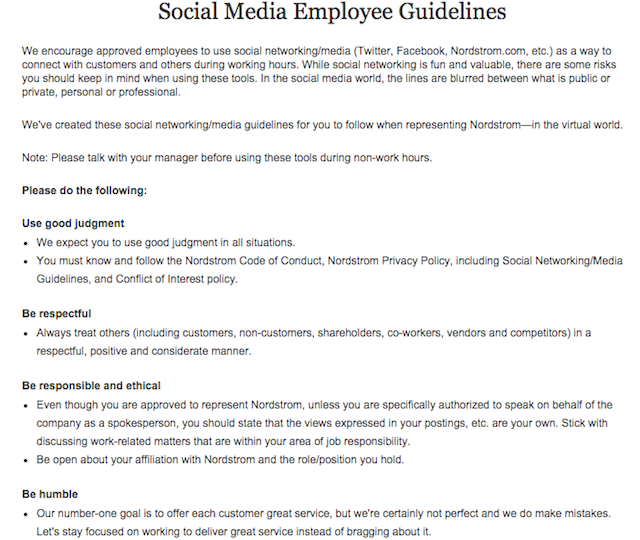
Business has gone digital and there’s no doubt about it. There has always been a social element to business. Word-of-mouth marketing is still a significant driver of purchase decisions. But that once private interaction is now taking place on a public stage where you and your competitors can join in.
This digital revolution has turned businesses into social butterflies. Social media permeates every aspect of your business, whether it’s across departments or your rank. Today 74% of online adults use social networking sites, yet 73% of companies of companies lack social media policies.
So, how can you make sure your employees’ social media usage doesn’t negatively affect your company? That’s where having a social media policy can help. If you currently lack a social media policy, this guide will help walk you through the creation process. If you already have one, it’s best to use this as an opportunity to review your social media policy and make sure everything is accurate and up to date.
What Is a Social Media Policy?
Let’s start with the basics. A social media policy is a code of conduct that provides guidelines for employees who post content online either as part of their job description or personal brand.
The goal of a social media policy is two-fold:
- It sets expectations for appropriate behavior online with regard to the company.
- It protects employers from legal issues or potential social media crises.
Too often businesses create social media policies after an unfortunate incident occurred—such as an employee mistakenly Tweeting from the company account instead of their personal account. Creating a policy early on will help you to proactively avoid these situations in the first place.

The first decision you’ll need to make when it comes to creating a social media policy is the approach. Some companies write one complete social media policy that addresses all currently available social platforms, while others compose policies as they need them.
Choosing the latter is definitely the least time intensive of the two, but it also leaves room for potential problems. For example, if a policy can’t be created before your marketing team adopts a new social platform, it could lead to some confusion about what’s acceptable and what’s not.
Who Is a Social Media Policy For?
Although your marketing and customer support departments are responsible for the bulk of your company’s outgoing messages, social media is for everyone. That means anyone from the CEO to the marketing manager to the quality control intern is using social media, and chances are they’re using it while at work.
A social media policy is especially important if employee advocacy is a priority. It’s important that everyone within your company is clear on the communication guidelines and principles. A strong social media policy will empower your team to take action and make educated decisions while representing your brand online.
You’ll want to be sure to identify who the social media policy applies to within your policy. This can be achieved very easily. Take this example from Cisco:

What to Include in Your Social Media Policy
There are a lot of great social media policies to review from other companies, but keep in mind that your policy should be unique to your company. That said, some components are universal. At the very minimum, your policy should include prohibitions against:
- Sharing confidential or proprietary company information, including details about clients and customers
- Posting derogatory, defamatory or inflammatory content
- Posting pictures or other information that even implies that they have engaged in illegal conduct
Other than those housekeeping items, here are six additional topics to address in your social media policy:
1. Transparency
You’ll want to consider how you’d like employees to represent themselves online. For example, some employees have separate Twitter handles for business communications, while others rely on their personal accounts for everything. In the event of the latter, employees should clearly state that they work for the company—especially if they’re discussing business, product or competitor-related matters.
For those with personal profiles, you’ll also want to think about whether you’d like them to include a disclaimer, like these:


Remind employees that claiming or implying to speak on behalf of the company is not allowed—unless their job description states otherwise. Adding a disclaimer helps your employees’ followers decipher between official company statements and general opinion.
2. Crisis Management
Things go wrong, and it’s natural for people connected to the controversy to want to help. But in the event of a social media crisis, you want to eliminate as much uncertainty as possible, and that means knowing who is in charge of what and when.
Most of employees will take a step back and let those with the proper training, such as community managers, social media managers and public relations teams, take over. In your social media policy, explain how you’d like your team to react during a crisis situation. You don’t have to go into a lot of detail here, but you should have procedures laid out in another document. Our Social Media Crisis Management Guide can help you get started if you haven’t already.
3. Privacy
Encourage employees to be smart about protecting themselves. Whether they’re using a branded social media account or a personal one, proper action should be taken to prevent breaches. This means using secure passwords, logging out of accounts while on public computers and using common sense when creating new profiles and customizing settings. Should an employee’s account become compromised, make sure he or she knows the next steps to take.
This also serves as a reminder for employees to think before they post. Content published online is easily discoverable and will remain that way for years. Employees should use sound judgment before posting or commenting online, and always defer to a professional language and behavior.
4. Compliance
Depending on the industry you’re in, you might have governing principles or regulatory bodies to follow. For example, federal government, alcohol and health care employees face tough regulatory challenges regarding social media engagement.
If employees are using branded social media profiles, you’ll need to ensure workers understand the various rules and regulations associated with your industry. Your social media policy is a good place to introduce employees to the different compliance issues. You might want to create separate documents depending on the regulation or the department.
Employees should also be expected to adhere to general laws and regulations, such as those related to copyright, data protection, financial reporting and so on.
5. Endorsement
People love it when their content is recognized. Liking, commenting or sharing user-generated content is a great way to spark engagement. In fact, 76% of Instagram users believe that receiving likes encourages them to publish more, and 65% said they feel flattered when a brand likes their post. That being said, your social media policy should clearly define rules regarding brand endorsements and how your employees can avoid confusion.
Make it clear that your company doesn’t endorse people, products, services and organizations. Official company accounts shouldn’t be used to provide such endorsements. When using a personal social media account, employees should be careful not to imply endorsement on behalf of the company.
6. Have Fun
Social media is a business tool, but it’s also an opportunity to show the lighter side of your company. Employees should be personable and participate in lively, natural conversations. If they’re constantly pushing robotic corporate communications, then they’re not helping themselves or the company. Followers can see through marketing tactics. Your employees should feel empowered to discuss what they’re passionate about as long as the delivery is appropriate and doesn’t violate any other area of your policy.
Start Writing
As you’re drafting your social media policy, be mindful of the tone and language you’re using. You’ll want to avoid using too much legal jargon because some employees might not understand it while others could avoid reading it all together. You also want to call attention to critical elements with bullet points or some other formatting technique. Don’t over complicate this. A social media policy is an important document for employees to come back to if need be. Do everything you can to make it easy for your team to read, understand and adopt what’s stated within the policy.
Take a look at Nordstrom’s social media employee guidelines:

It’s empowering, concise and easy to read. Nordstrom did an excellent job of conveying critical communication procedures to its employees.
Remember that social media is all about collaboration. If you have a very active employee advocacy initiative, it’s best to design your policy around what your employees can do rather than what they cannot.
One last thing before you start drafting your social media policy: The suggestions mentioned above are just that, suggestions. The rules you define and enforce will differ from brand to brand. We recommend talking this through with leaders from each department, as well as your legal team to ensure that objectives are being met and nothing gets left out.
The post Your Guide to Creating a Social Media Policy appeared first on Sprout Social.
from Sprout Social http://ift.tt/1QAsWab
Do You Know You Can Buy Instagram Followers from SocialKingMaker.com?
